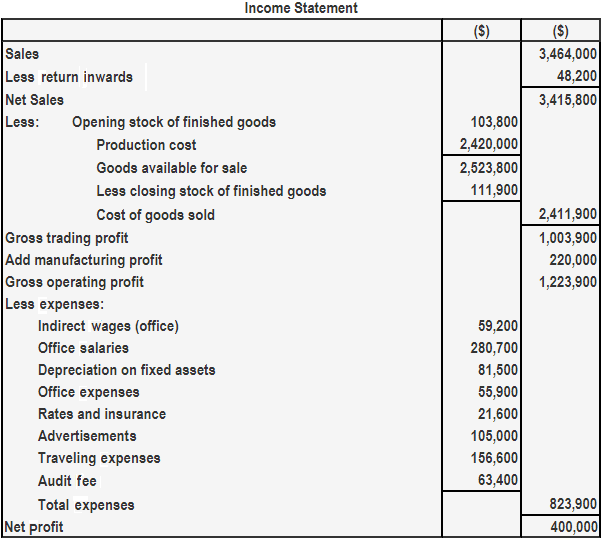The income statement for merchandising and manufacturing companies differs in the reporting of the cost of the merchandise (goods) available for sale and sold during the period. This lecture will clarify how to prepare the income statement for a manufacturing company. A manufacturing company has no need to prepare a manufacturing account, statement of production, or a cost sheet, before preparing the income statement. The income statement remains the same except for the transfer of goods manufactured to a trading account to be treated as finished goods (at par with purchases). Thus, the company that carries on manufacturing activity besides trading activity tends to prepare: Preparing a manufacturing account shows the cost of materials consumed, productive wages, direct and indirect expenses of production, and the cost of finished goods produced. Manufacturing account is debited with: The total cost of production is credited to the manufacturing account by giving a debit to the trading account.
Some manufacturing companies prefer to transfer finished goods from the factory to the warehouse at an increased price, by adding a pre-set margin (called the manufacturing profit) to the production cost. When preparing the income statement, the enhanced cost of production is taken into account to compute the cost of goods sold. Goods are transferred to the trading account at a value which the business would have paid had these goods been bought from other manufacturers. This approach ensures that the trading account shows a more realistic gross trading profit or loss The manufacturing profit, i.e., the excess of the transfer value of goods manufactured over their actual production cost, represents the savings the company makes by manufacturing the goods Given the rate for marking up the production cost; the accounting treatment would be as follows: The amount of markup is added to production cost, i.e., the manufacturing profit. The above entry would increase the production cost, thereby reducing the gross profit disclosed by the trading account. At the same time, crediting the profit and loss account by the amount of manufacturing profit does not affect the net profit. Assume that finished goods are transferred from the factory to the warehouse at production cost plus a 10% manufacturing profit. Show the relevant statements.Introduction
Explanation
Example
Solution


How to Prepare Income Statements for a Manufacturing Company FAQs
The income statement for merchandising and manufacturing companies differs in the reporting of the cost of the merchandise (goods) available for sale and sold during the period.
A manufacturing company has no need to prepare a manufacturing account, statement of production, or a cost sheet, before preparing the income statement.
A manufacturing company differs from a merchandising company in the reporting of the cost of the merchandise (goods) available for sale and sold during the period. A manufacturing company has no need to prepare a manufacturing account, statement of production, or a cost sheet, before preparing the income statement. The income statement remains the same except for the transfer of goods manufactured to a trading account to be treated as finished goods (at par with purchases).
A manufacturing company reports depreciation as a separate item in the income statement after the cost of goods sold. The amount of depreciation is deducted from the gross profit to arrive at the net profit before tax.
A manufacturing company reports taxes as a separate item in the income statement after the net profit. The amount of taxes is deducted from the net profit to arrive at the bottom line, i.E., The net profit after tax.
True Tamplin is a published author, public speaker, CEO of UpDigital, and founder of Finance Strategists.
True is a Certified Educator in Personal Finance (CEPF®), author of The Handy Financial Ratios Guide, a member of the Society for Advancing Business Editing and Writing, contributes to his financial education site, Finance Strategists, and has spoken to various financial communities such as the CFA Institute, as well as university students like his Alma mater, Biola University, where he received a bachelor of science in business and data analytics.
To learn more about True, visit his personal website or view his author profiles on Amazon, Nasdaq and Forbes.











